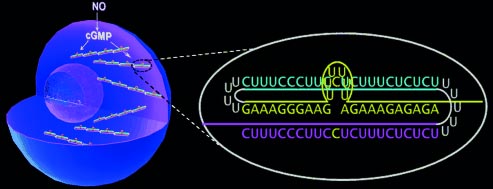A Sink for Signals

The transmission of signals within cells is dependent on cyclic guanosine monophosphate (cGMP) as an important secondary messenger. German scientists have now developed an RNA that binds cGMP. As reported in the journal Angewandte Chemie, it is possible to suppress the cGMP signal cascade in genetically modified cells that produce this RNA.
cGMP plays an important role in processes such as the relaxation of the smooth muscle tissue in blood vessels and consequently in the regulation of blood pressure. Malfunction of the cGMP signaling pathway may be related to cardiovascular disease.
Experimental manipulation of the endogenous cGMP levels in cells should lead to a better understanding of the spatial and temporal dynamics involved, as well as the functionality of cGMP. While there are many ways to stimulate cGMP, including the use of nitrogen monoxide (NO), researchers have thus far not had a means to artificially lower cellular cGMP concentration.
Scientists from the Universities of Stuttgart and Tübingen have now developed a method by which they can “trap” cGMP molecules in cells. To achieve this they genetically modified the cells to produce specially designed RNA molecules that bind cGMP.
RNA, ribonucleic acid, is familiar to us as a building block of ribosomes, an amino acid transporter, and as messenger RNA, which copies blueprints from DNA and transports them to the ribosomes, where protein synthesis takes place. Further physiological roles have also now been found, such as catalytically active RNAs or RNAs that regulate gene expression by binding to complementary sequences. In addition, there are riboswitches, sequences in the messenger RNA that bind low-molecular metabolites and thus regulate gene expression.
A team led by Stuttgart chemist Clemens Richert and Tübingen biochemist Robert Feil has now successfully used specially developed RNA sequences to reduce the concentration of small molecules capable of base pairing in cells. To achieve this, the Stuttgart chemists developed a special folding motif that binds cGMP. The structure is based on a triple strand of RNA, known as a triplex. One of the three strands forms a loop that frames the binding cavity for cGMP. This motif is repeated multiple times in a long continuous sequence, so the researchers named their RNA construct “endless”.
In order to test the functionality of the “endless” construct in living cells, the biochemists in Tuebingen produced an artificial gene that codes for the “endless” RNA, and introduced it into cells obtained from the blood vessels of mice. This is a well-established model for the study of cGMP signaling pathways. In these cells, NO triggers signal cascades transmitted by cGMP. In cells that expressed “endless”, these cascades were suppressed and the cGMP level was significantly lower than in control cells. The “endless” RNA acts as a sink for cGMP and should be very useful in further research into the physiological role of cGMP.
About the Author
Clemens Richert is a synthetic organic chemist and Chair of Biological Chemistry at the University of Stuttgart. His research focuses on functional nucleic acids. He is also the chairman of the German Nucleic Acid Chemistry Society, DNG e.V. (http://dnarna.de).
Author: Clemens Richert, Universität Stuttgart (Germany), http://chip.chemie.uni-stuttgart.de/
Title: Endless: A Purine Binding Motif that Can Be Expressed in Cells
Angewandte Chemie International Edition, Permalink to the article: http://dx.doi.org/10.1002/anie.201403579
Media Contact
All latest news from the category: Life Sciences and Chemistry
Articles and reports from the Life Sciences and chemistry area deal with applied and basic research into modern biology, chemistry and human medicine.
Valuable information can be found on a range of life sciences fields including bacteriology, biochemistry, bionics, bioinformatics, biophysics, biotechnology, genetics, geobotany, human biology, marine biology, microbiology, molecular biology, cellular biology, zoology, bioinorganic chemistry, microchemistry and environmental chemistry.
Newest articles

Decoding Cancer: 40 Years of Breakthroughs in Genetic Research
Cancer in children and adolescents is rare. Nevertheless, malignant diseases are still one of the most common causes of death in this age group. Survivors of childhood or adolescent cancer…

Let’s Think Before the First Drink: How Early Substance Use Might Lead to Brain Structure Differences Among Adolescents
Many differences appeared to exist prior to any substance use, pointing to the role brain structure may play in substance use risk, NIH-supported study suggests. Studies reveal factors that expose…

Combating Kidney Cancer Using Enhanced Immunotherapies
Medical University of South Carolina Hollings Cancer Center researcher receives Department of Defense Early Career Scholar Award to improve immune therapies by targeting resistant kidney tumors. A Medical University of…



